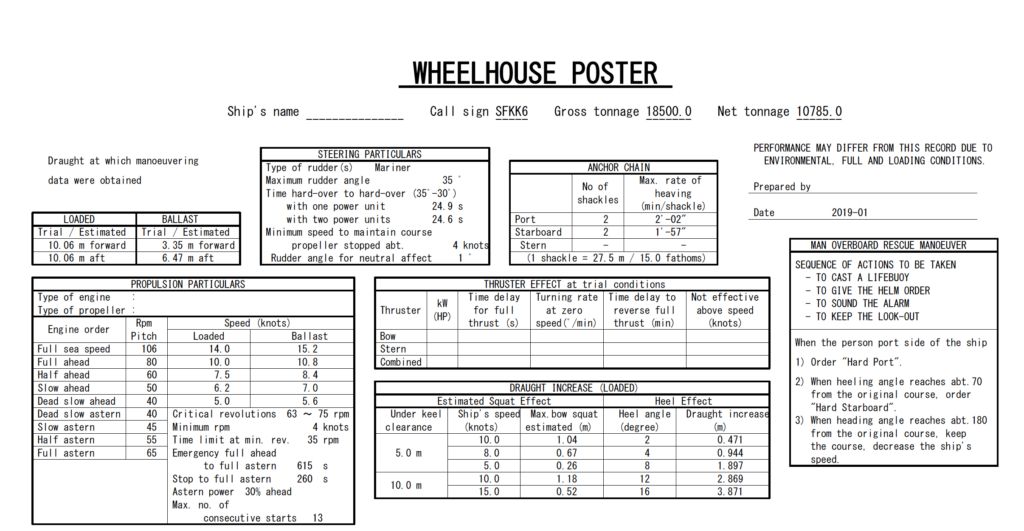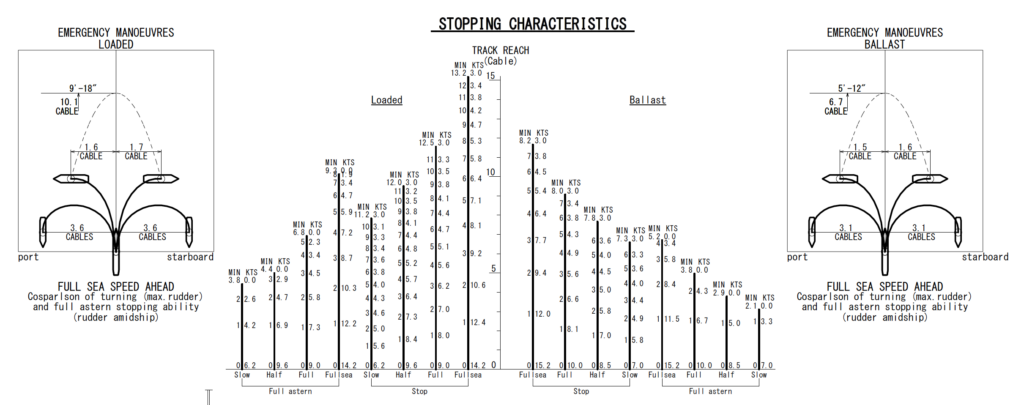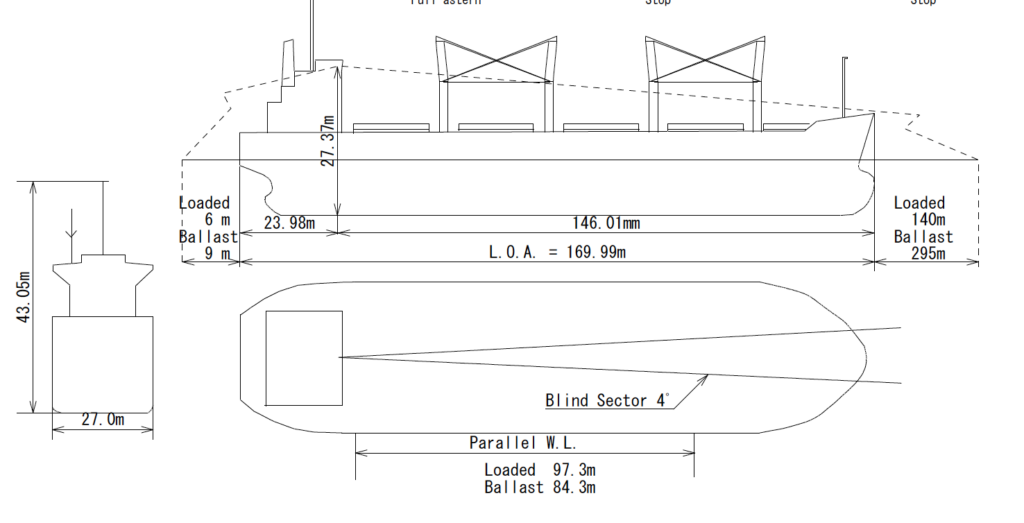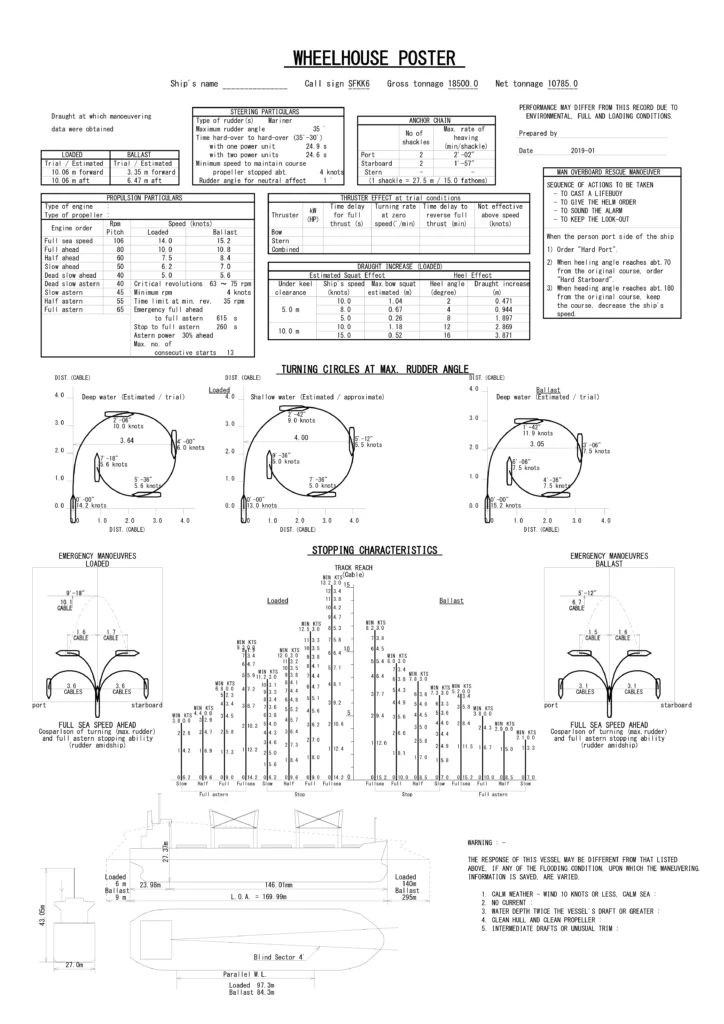The Wheel House poster is an indispensable material on the bridge as it provides necessary information for the Bridge personnel and Pilots.
The Wheelhouse Poster is a large document posted in a conspicuous area on the bridge. It contains the general particulars of the ship, engine characteristics, and stopping distances in laden and ballast conditions.
It will also provide illustrations of ship movement including steering particulars, turning circles, as well as emergency maneuvers. The performance of the ship may differ due to environmental, hull, and conditions.
Information That Can Be Obtained From The Wheelhouse Poster
The content of The Wheelhouse Poster on ships is regulated by various international and national maritime organizations and agencies. These organizations and agencies set standards for the information that must be included on the poster, as well as the format and layout of the poster.
The International Maritime Organization (IMO) is a United Nations agency responsible for setting standards for the safety, security, and environmental performance of international shipping.
The IMO has developed a number of regulations and guidelines. IMO Resolution A.601(15) directly regulates the content of The Wheelhouse Poster and Pilot Card, however, the International Safety Management Code, or ISM Code, outlines the requirements for a Safety Management System (SMS) on board ships. The SMS is a systematic approach to managing safety on board a vessel, and The Wheelhouse Poster is an important part of this system.
The poster should be easy to read and understand and should be prominently displayed in the wheelhouse or other appropriate locations on the vessel. Let’s take a closer look at the information that can be found on the poster, which is normally placed on the most visible and easy-to-access places on the ship’s bridge.
The topmost information of the wheelhouse poster would be the particulars of the ship. This includes the Ship’s name, call sign, gross tonnage, and net tonnage. More detailed information like summer and winter displacement, freeboard, and deadweight information can be found in the Pilot card and general ship’s particulars. As the ship communicates with vessel traffic services and other vessels, this information from the poster is vital, but might be incomplete in communication with VTS or Port Authorities.
The next part of the poster would be the drafts of the vessel, steering particulars, and anchor chain data. Drafts can either be in loaded/ballast condition or departure drafts and arrival drafts. This is used by Pilots to make sure the ship has enough underkeel clearance and is away from shallow water.

Steering particulars reminds the officer of the watch as well as the helmsman of what type of rudder the ship has. It allows bridge personnel what is the maximum rudder angle and time needed from hard over port to starboard hard over. This is being utilized during docking and undocking maneuver.
Another important part of the poster is the information on anchor chains. This part informs the ship’s crew and pilots how many anchors this vessel currently has including the spare. It also details the length of shackles of each anchor as well as the rate of heaving per minute. One shackle equates to fifteen fathoms, ninety feet, and 27,5 meters.
The wheelhouse poster also includes the propulsion particulars of the vessel. Here, the type of engine and type of propeller is indicated. This table would give the corresponding rpm(revolution per minute) to each specific speed of the engine. From full speed to dead slow ahead both in ahead and astern propulsion.

In addition, critical RPM is highlighted to inform bridge officers and Pilots during channeling and berthing/unberthing operation. The actual speed of the vessel in knots is also displayed for ballast and loaded conditions.
For some vessels, like containerships, car ships, and cruise ships, additional information regarding the thruster effect and draft effect is also included. The effects of the bow, stern, and combined thruster on the vessel are displayed including time delay and turning rate.
The draught effect includes information on the Squat effect and heel effects on the vessel. It tabulates under keel clearance to the corresponding ship’s speed and maximum squat estimate in meters. The heeling effect provides data on heel angle in degrees and the increase of draft.
Engine Characteristics and Stopping Distances
Knowing the characteristics of the main engine enables the crew to maneuver the ship and contributes to better pilotage. This would include the output and service speed of the ship. This enables the pilots to make sound decisions during channeling, docking/undocking, or shifting of the vessel.

The stopping distance is defined as the distance, in which the ship will continue to move after the action is taken to stop the main engine and until the ship comes to a full stop. Information may be provided for sea speed, harbor speed, and half-speed, including astern propulsion. It may be provided for light and loaded conditions.
SOLAS Chapter 5 regulates visibility for the navigational bridge and has a list of conditions to be followed in Regulation 22:
The view of the sea surface from the conning position shall not be obscured by more than two ship lengths, or 500 m, whichever is the less, forward of the bow to 10° on either side under all conditions of draught, trim and deck cargo.
SOLAS Chapter V, Regulation 22 – Navigational bridge visibility
The wheelhouse poster has a clear summary for the bridge team about the blind sector and obscured view fore and aft in both conditions, loaded and ballast.

The Wheelhouse Poster Templates
The Wheelhouse Poster is normally prepared and produced by the shipyard as a result of sea trials in the final stages of the shipbuilding process. Modern posters are printed on aluminum sheets and are robust and will serve during the full ship lifespan.
It may appear that poster should be replaced due to the loss of the original or significant construction charges made under the supervision of the classification society. In this case, we offer to use these templates according to IMO Res. A. 601 (15) and USA CFR 33 164.35 – 7.
The Wheelhouse poster – A4 Format (Editable Excel file)
The Wheelhouse poster – Full-Size Format (Editable Excel file)
The Wheelhouse Poster – IMO A206 Template in PDF format





Leave a Reply